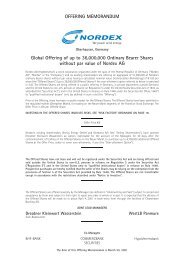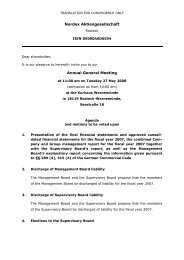Download WindpowerUpdate 15 - Nordex
Download WindpowerUpdate 15 - Nordex
Download WindpowerUpdate 15 - Nordex
You also want an ePaper? Increase the reach of your titles
YUMPU automatically turns print PDFs into web optimized ePapers that Google loves.
When Less Can Mean More<br />
<strong>Nordex</strong> Repowering<br />
Projects in Denmark<br />
The repowering boom is sweeping over Denmark, and today an important replacement<br />
of small and old wind turbines by new and more powerful wind turbines is<br />
taking place.<br />
It is expected that before the end of 2002, more than 200 MW<br />
will be installed replacing about 70 MW derived from old and<br />
small wind turbines. <strong>Nordex</strong> is involved in the Danish repowering<br />
program by several projects using the well-proven N50/800<br />
kW and N60/1300 kW machines.<br />
The biggest <strong>Nordex</strong> repowering project is located at the<br />
Danish island Bornholm in the Baltic Sea. Eight N60/1300 kW<br />
and three N50/800 kW turbines are to replace approx. 35 old wind<br />
turbines ranging from 20 kW to 99 kW. In Jutland, along the ferry<br />
port of Ebeltoft facing to the Kattegat Sea, <strong>Nordex</strong> will install<br />
four N60/1300 kW wind turbines. These new and efficient wind<br />
turbines will replace 18 old turbines each of 55 kW, and once<br />
described as the first offshore wind farm in Denmark. The last<br />
<strong>Nordex</strong> repowering projects are dispersed over the country in<br />
the southern part of Jutland. 24 small wind turbines are being<br />
replaced by three N50/800 kW and two N60/1300 kW. All the<br />
<strong>Nordex</strong> repowering projects will be installed this year.<br />
The Danish repowering program was implemented in 2001,<br />
the purpose being to reduce the number of small and old machines<br />
(less than <strong>15</strong>0 kW, however most of the replaced machines<br />
have a capacity of less than 100 kW) and to increase the wind<br />
generation capacity. The program will continue until the end of<br />
2003. According to the program, the projects being installed in<br />
2002 are entitled to receive an average of 3 0.08 per kWh for the<br />
first 12,000 full load hours of operation (approx. 5 years) then<br />
dropping to 3 0.058 per kWh for the next 22,000 full load hours<br />
(approx. 10 years). From January 1st , 2003, the kWh prices drop<br />
to the market price plus a subsidy of 3 0.013 per kWh for turbines<br />
installed after that date. However the limit is 3 0.048 per kWh,<br />
so if for instance the market price per kWh is 3 0.040, the subsidy<br />
will be limited to 3 0.008 per kWh.<br />
Therefore, the Danish wind turbine market will reach a dead point<br />
in 2003, at least in the beginning of the year, Jørn Motzkus,<br />
Sales Manager <strong>Nordex</strong>, expects. However, he envisages that<br />
the Scandinavian electricity market will change drastically within<br />
the next few years. On the one hand, the Scandinavian grid<br />
infrastructure will be even more efficient, and the grid system in<br />
Denmark, Norway, Sweden and Finland will be more and more<br />
integrated and soon become one system. On the other hand, a<br />
general lack of power in these countries will occur favouring<br />
Photo montage of the four new N60/1300 kW at Ebeltoft.<br />
the use of power from wind energy. Several incidents support<br />
this forecast. The demand for electricity is increasing and will<br />
continue to increase in the coming years, and the existing power<br />
supply will not be able to match this demand. For instance, in<br />
Norway, the demand for power is increasing by approx. 2 % per<br />
year, and at the same time, the country has decided not to extend<br />
the installations of hydraulic power stations as a further extension<br />
will have too much impact on the nature. Today, Norway’s<br />
electricity is 100 % hydraulic power. A possible drought one year<br />
will have a serious influence on the electricity market. The power<br />
prices will rise, and even a rationing of the power might be a<br />
consequence. The higher power prices and the insufficient power<br />
supply will favour the development of new power production<br />
capacity, including wind power.<br />
Nr. <strong>15</strong> ı December 2002 17












